
Return to Causewayed ring-ditches and roundbarrows excavated on Thanet
Display Contents
Causewayed ring-ditches and roundbarrows excavated on Thanet
Link -
Lord of the Manor I
Phases 1 and 2
Phases 3 and 4
The carved chalk objects
The Urn and arrowhead
Spindle whorls
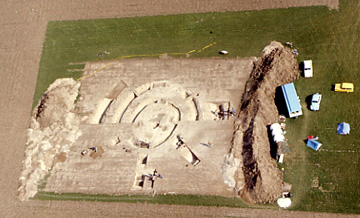
Photographer unknown
Set out below are some plans (taken
from the report written by Nigel
Macpherson Grant) which illustrate the four separate Phases of activity
which combined to create the Triple ring-ditch monument of Lord of the
Manor I (described briefly in the previous Display on Thanet's
Causewayed ring-ditches and roundbarrows).
![]()
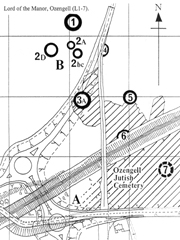
The LOM ring-ditch complex
By Perkins, from Fisk 2003
LOM I is one of only two Triple
ring-ditch monuments known to exist on Thanet and forms a very special
part of Thanet's archaeological heritage.
The excavation of this site (led by Nigel Macpherson Grant of the Thanet Archaeological Unit in 1976) produced a variety of rare and important finds, some of which are shown below.
It is hoped to add much more information, illustrations and photographs to this Display on one of Thanet's most important and interesting monuments when time permits.
The excavation of this site (led by Nigel Macpherson Grant of the Thanet Archaeological Unit in 1976) produced a variety of rare and important finds, some of which are shown below.
It is hoped to add much more information, illustrations and photographs to this Display on one of Thanet's most important and interesting monuments when time permits.
Nigel Macpherson Grant
(TAU)
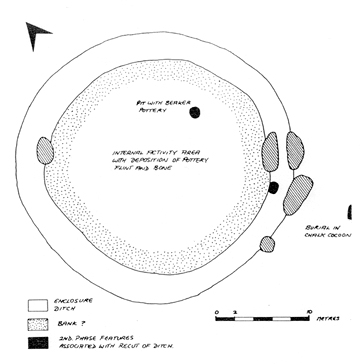
Phase 1
(Later Neolithic?)
The large outer ditch was dug first and allowed to infill, perhaps after a period of abandonment. There was no evidence for a causeway.
The large outer ditch was dug first and allowed to infill, perhaps after a period of abandonment. There was no evidence for a causeway.
Phase 2
(Beaker, circa
1950-1850 BC)
The infilled outer ditch was subsequently re-cut during the Beaker Period. Pit F1 was also dug. A single inhumation burial (1A) beyond the outer ditch, contained within a chalk 'cocoon' likely belongs to this phase.
The infilled outer ditch was subsequently re-cut during the Beaker Period. Pit F1 was also dug. A single inhumation burial (1A) beyond the outer ditch, contained within a chalk 'cocoon' likely belongs to this phase.
Nigel Macpherson Grant
(TAU)
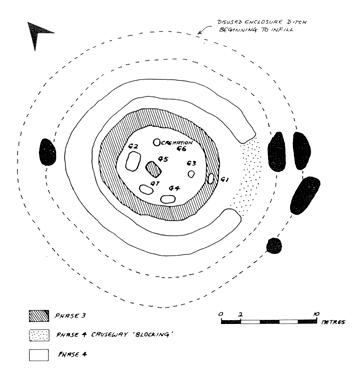
Phase 3
(possibly circa 1800-1750 BC)
The re-cut outer ditch began to infill again and then a rectangular grave (G5) and the inner ditch (a roundbarrow) was dug. The grave contained the crouched inhumation burials of a 'father and daughter'. No clearly dateable finds.
The re-cut outer ditch began to infill again and then a rectangular grave (G5) and the inner ditch (a roundbarrow) was dug. The grave contained the crouched inhumation burials of a 'father and daughter'. No clearly dateable finds.
Once the inner ditch
became
half-infilled the middle ditch was constructed with
a causeway to the south-east. Six burials comprising one cremation
(G6, a cord-decorated pot, possibly a Food Vessel, containing the ashes
of a baby and accompanied with a barbed and tanged flint arrowhead) and
five
single crouched
inhumations (G1-4 and 7) were deposited.
Finally the causeway was 'blocked' by the digging of a trench
across it.
Disarticulated human bone was recovered
from both the lower and upper
fills of all three ditches with the exception of the upper fill of the
final, middle ditch.
Carved chalk objects were recovered from
the
primary
silts of the inner ditch (a 'cup/lamp'), the middle ditch (a
'cup/lamp' and two blocks with criss-cross carvings) and the outer
ditch (a 'cup/lamp').
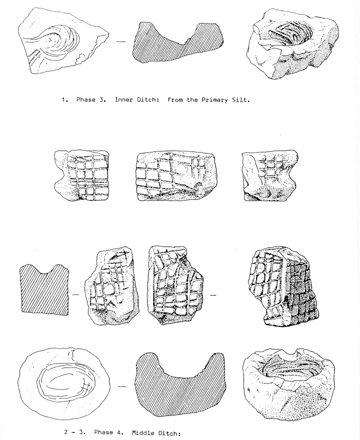
Illustrated by
Nigel Macpherson Grant
(TAU)
A fourth
object not featured in the above drawing was recovered from the Outer
ditch and is pictured left.
Their purpose and function are a mystery. Could they be small ceremonial cups? Animal fat lamps perhaps (similar objects have been found in flint mines). What inspired the creation of the criss-cross carved blocks?
Or are they all just doodles (surely not!).
Their purpose and function are a mystery. Could they be small ceremonial cups? Animal fat lamps perhaps (similar objects have been found in flint mines). What inspired the creation of the criss-cross carved blocks?
Or are they all just doodles (surely not!).
These objects were part of an Early
Bronze Age cremation
burial (Grave 6 on the plan shown further above) interred during Phase
4 of the monument's life. The pot is a Food Vessel and is one of only
two known to have been found on Thanet (the other being from a
Beaker barrow at South Dumpton Down). These vessels are very rare in
this part of the Country and Thanet's examples comprised 2/3 of Kent's
recorded total as of 2004 (Gibson in Perkins 2004).
It is cord-decorated, having the impression of a twisted piece of cord which had been wound around the vessel when the clay was still soft. In one place the angle of the decoration turns through ninety degrees and forms what looks like a patch on the side of the pot.
It is cord-decorated, having the impression of a twisted piece of cord which had been wound around the vessel when the clay was still soft. In one place the angle of the decoration turns through ninety degrees and forms what looks like a patch on the side of the pot.
Nigel Macpherson Grant
(TAU)
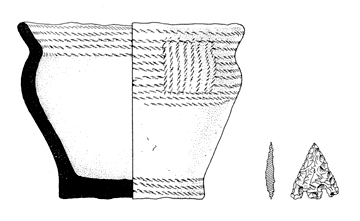
The barbed and tanged flint arrowhead is
of Green's Conygar Hill
type. This form is
found throughout Britain, frequently with Early Bronze Age Food Vessels
and are most frequently associated with cremation burials (Green 1980).
Scale in centimetre divisions
Aside from the many finds discovered at LOM I which might be
considered as prestigious and more likely to be associated with
ceremonial or ritual deposition, more domestic items such as these
Early Bronze Age pottery spindle whorls were also recovered.
These coarse-looking and fragile pieces are actually a very rare find and their presence at this non-domestic site might equally have been the result of purposeful deposition. They are the oldest known examples from Thanet.
These coarse-looking and fragile pieces are actually a very rare find and their presence at this non-domestic site might equally have been the result of purposeful deposition. They are the oldest known examples from Thanet.
TAU - Thanet Archaeological Unit.
Fisk P.M. 2003. An examination of the excavated ring ditch enclosures on The Isle of Thanet. Unpublished Degree thesis.
Green S.H. 1980. The flint arrowheads of the
Macpherson Grant N. 1977. Excavation of a Neolithic/Bronze Age Site at Lord of the Manor, Haine Road, Ramsgate. Isle of Thanet Archaeological Unit, Publication No. 1.
Perkins D.R.J. 2004. Oval barrows in Thanet, in Cotton J. and Field D. Towards a New Stone Age. CBS Research Report 137.
Much thanks go to Nigel
Macpherson Grant and Dave Perkins for their exploration of this
fascinating monument.
Version 1 - Posted 21.10.06
All
content © Trust for Thanet Archaeology